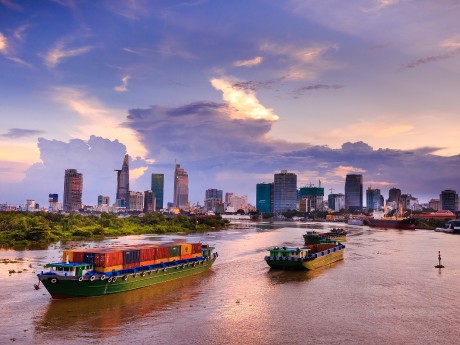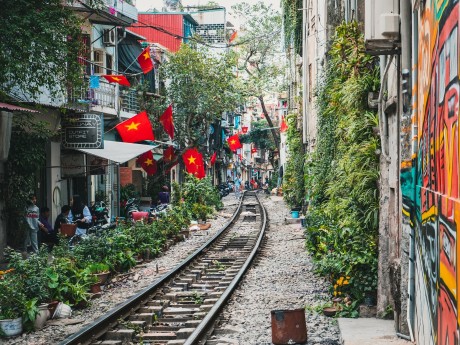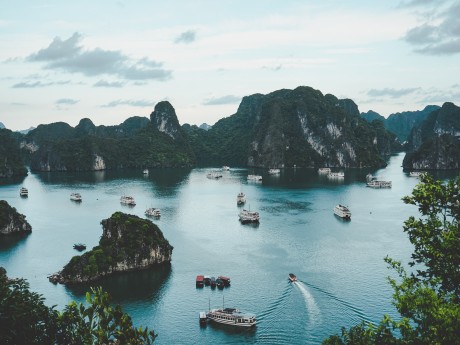Vietnam: Ho Chi Minh & Hanoi
Embark on an enchanting journey through Vietnam, immersing yourself in its rich history and captivating landscapes. The adventure begins in Ho Chi Minh City, where modernity and tradition collide. Explore the historic Cu Chi Tunnels, a network of underground passages used during the Vietnam War. Delve into the past at the War Remnants Museum and discover the bustling Ben Thanh Market, a paradise for shopping and sampling local street food.
Read more
Embark on an enchanting journey through Vietnam, immersing yourself in its rich history and captivating landscapes. The adventure begins in Ho Chi Minh City, where modernity and tradition collide. Explore the historic Cu Chi Tunnels, a network of underground passages used during the Vietnam War. Delve into the past at the War Remnants Museum and discover the bustling Ben Thanh Market, a paradise for shopping and sampling local street food. Next, experience the cultural heart of Vietnam in Hanoi. Stroll through the charming Old Quarter, a labyrinth of narrow streets bursting with vibrant markets and traditional shops. Uncover the secrets of Vietnamese cuisine through a hands-on cooking class, learning to create authentic dishes. The pinnacle of your Hanoi experience awaits at Halong Bay, a UNESCO World Heritage site. Sail among the stunning limestone karsts and emerald waters, exploring hidden caves and indulging in breathtaking vistas. Join us for this immersive Vietnam tour, where history, culture, and natural beauty converge for an unforgettable experience. Waterviews strives to offer accommodation options within walking distance of water and/or in an area of touristic interest. Our prices include taxes (but excludes local tourist taxes). Customize your trip to your personal preferences with optional activities (hit the “Add Activities’’) or change hotels, etc. Contact us for customization at no extra cost at:Service@waterviews.com
Destinations
- Ho Chi Minh City
- Hanoi
Itinerary
Ho Chi Minh City

Set at the crossroads of ancient and modern-day Vietnam, Ho Chi Minh City - formerly known as Saigon - is a diverse and energetic melting pot with many corners to discover. From its traditional street markets and budget hostels to its luxury boutiques and high-class restaurants, Ho Chi Minh truly offers something for everyone, and makes a great starting point for further exploration of the country such as the nearby Mekong Delta.
Read more
Set at the crossroads of ancient and modern-day Vietnam, Ho Chi Minh City - formerly known as Saigon - is a diverse and energetic melting pot with many corners to discover. From its traditional street markets and budget hostels to its luxury boutiques and high-class restaurants, Ho Chi Minh truly offers something for everyone, and makes a great starting point for further exploration of the country such as the nearby Mekong Delta.
Additional Information
Following the fall of Saigon in 1975, Saigon was renamed Ho Chi Minh City. However the old Saigon name is still used by both Vietnamese and foreigners, especially when referring to the most central part of the city to which most tourists flock. Although the capital of a united Vietnam is Hanoi in the north, Ho Chi Minh City remains Vietnam's main economic and financial centre. While it does not have the long history that cities like Hanoi and Hue have, it is Vietnam's most modern and cosmopolitan city, with influences from the French former colonial rulers and the ethnic Chinese community in Cholon deeply embedded in the local culture, perhaps most visible in its cuisine.
Though Vietnam has been united since the conclusion of the Vietnam War, cultural differences arising from the division of Vietnam can be seen to this day. To this day, locals in Ho Chi Minh City tend to be more business-minded and less ideological than those in Hanoi in the north. In addition, Southerners also tend to be more hospitable towards Western visitors than Northerners. The Vietnam War — called the "American War" in Vietnam — remains a sensitive topic, and it is advisable not to bring it up in discussions with locals. Do not assume that all Vietnamese think alike, as many Southerners are still bitter about having lost to the North.
History
The first evidence of a settlement in the area dates back to the Funan Empire (1st - 6th century AD). Following the fall of the Funan Empire, the area eventually came under the control of Champa, during which it was named Baigaur. With the rise of the Khmer Empire, the Chams were eventually forced out, and the settlement was incorporated into the Khmer Empire and renamed Prey Nokor. It grew to have an ethnic Khmer majority, which remained even after the fall of the Khmer Empire, and it was not until the 17th century that ethnic Vietnamese started setting in the area. In 1698, by which time it already had an ethnic Vietnamese majority, the Nguyễn lords sent Nguyễn Hữu Cảnh to the area to establish Vietnamese administrative structures, thus incorporating it into the Vietnam's Lê dynasty. In time, the city of Prey Nokor came to be known by the Vietnamese name Sài Gòn.
Saigon was ceded to the French under the Treaty of Saigon in 1862, and became the capital of the French colony of Cochinchina, which covered most of what is today southern Vietnam. As a result, the city has a rich French colonial heritage, with many magnificent French colonial buildings in the city centre, along with a strong cafe culture. After independence in 1955, Saigon became the capital of the capitalist South Vietnam, with Hanoi becoming the capital of the communist North Vietnam. Saigon was captured by communist North Vietnamese forces in 1975, thus reuniting Vietnam under communist rule. The city was re-named Ho Chi Minh City by the victorious communists in 1976, though the old name Saigon continues to be commonly used by locals. Although Hanoi became and remains the capital of a unified Vietnam, Ho Chi Minh City continues to be Vietnam's largest city and main economic hub.
Climate
Ho Chi Minh City has a tropical climate with wet and dry seasons. The dry season which is from December to May. The most pleasant time to visit is from December to February when temperatures and humidity are lower. March and April are hot with temperatures that can reach up to 40°C (104°F). The wet season is long, usually beginning in May and ending in October is characterized by high temperatures and humidity. Cloudy weather is more common although periods of sunshine do occur during the wet season.
© Sourced from Wikivoyage
Hanoi

Immerse yourself in the diverse charms of Hanoi, Vietnam’s modern capital, and discover its rich and ancient history that has been shaped and influenced over the years by various different cultures. As one of the most unique and interesting destinations in Southeast Asia, Hanoi has something to offer for everyone, from its bustling Old Quarter and its historic temples to its varied culinary scene and lively nightlife.
Read more
Immerse yourself in the diverse charms of Hanoi, Vietnam’s modern capital, and discover its rich and ancient history that has been shaped and influenced over the years by various different cultures. As one of the most unique and interesting destinations in Southeast Asia, Hanoi has something to offer for everyone, from its bustling Old Quarter and its historic temples to its varied culinary scene and lively nightlife.
Additional Information
Invading forces from every direction agree: Hanoi makes a fine capital. It has held that title for more than a thousand years, through several invasions, occupations, restorations, and name changes. The Chinese conquered the imperial city of Đại La in 1408 and renamed it Tống Bình. Le Loi repelled the invaders in 1428 and applied the name of Lê Thái Tổ (黎太祖). For his efforts, he received the crown and a slew of legends about his heroic exploits, many centred around the Hoan Kiem Lake in the Old Quarter. The Nguyen Dynasty gave the city its modern name of Ha Noi in 1831, but they had transferred power to Hue by then. Hue remained the capital until 1887, when the French made Hanoi the capital of all Indochina. It changed hands again in 1954, when it was ceded to Ho Chi Minh and the Viet Minh after almost a decade of fighting, and it became the capital of North Vietnam. Upon reunification in 1975, it assumed that title for the entire country.
The first Western-style universities in Vietnam were founded in Hanoi, and today, it is the leading centre of scientific study and research in the country. Hanoi retains much of its older colonial charm, despite the battles that have raged over it. Conflict had the effect of making it largely oblivious of modern architecture, and as a result, few buildings in the city centre area are higher than five stories. The Old Quarter is second only to Hoi An for uninterrupted stretches of colonial and pre-colonial architecture, well-preserved on dense warrens of narrow, wonderfully atmospheric streets. It trades the commercial boom and sprawl of Ho Chi Minh City in the south for a more understated charm, worth enjoying for an extra day or two, and with countless transport options and travel agents, it makes a perfect base for exploration of the North. See also Indochina Wars.
As you walk along the street, you may find that people start talking to you. It is a cultural norm there to make conversation with strangers. They might ask you where you are from and other general questions. But if you are a man, be cautious if a comely young lady approaches you and initiates a conversation as she is likely after something. It may take a while to get used to such overt friendliness, however there are times when this could be useful, such as when you are lost or need help. There are self-help information booths around the Old Quarter, but their purpose mostly is give the impression that Vietnam "has arrived" technologically.
Climate
The Tet holiday (Lunar New Year) is in the spring. Flowers are most beautiful during this time of the year. The weather warms up, with occasional light rain during the week. Locals believe that these light rains bring prosperity and luck in the new year.
Summer, on the other hand, borders on intolerable. The heat alone would be alright, but it's coupled with oppressive humidity. At this time, visitors should be wary of mosquitoes as they abound. Hanoi has a perfect climate for the proliferation of insects.
There is something unique about Hanoi’s autumn. The weather is perfect, with less humidity in the air. The temperature drops, allowing people a chance to flaunt their sweaters and jackets. There is a species of tree, "cay hoa sua", which only flowers in autumn. The flower has a very distinct odour. If you visit Hanoi during the fall, ask locals about this tree and where you might sniff its distinct aroma.
Winter can be uncomfortable because it is not only cold, but also humid. Winter in Hanoi feels even colder than it is because Vietnamese houses lack central heating. Many houses have no heating at all.
January is a drizzly month, and it may rain for one or two days or all week long.
© Sourced from Wikivoyage





